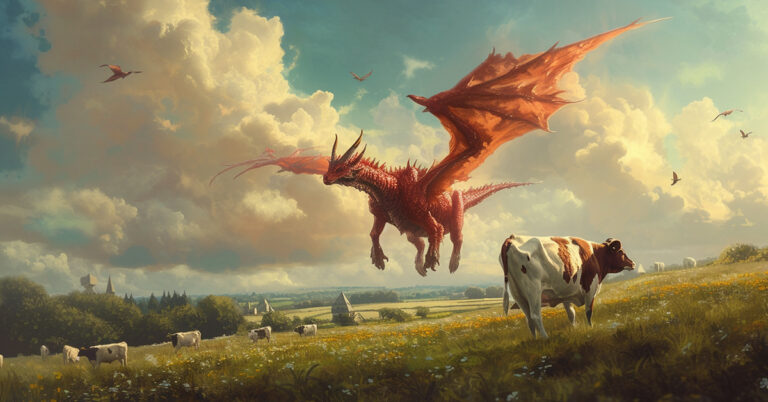Whether they survive or not, most D&D players will remember their first encounter with a dragon, be it from one of the introductory campaigns and you’re running into Venomfang, or something of the DM’s own concoction, they are always memorable encounters.
Outside of epic encounters, as a DM, you might like to think about what your dragon(s) are doing when they’re not interacting with players, and food in D&D can provide some interesting angles to flesh out your characters and campaigns.
Table of Contents
What do dragons eat in D&D?
Anything and everything is the short answer. Dragons are the apex predators of the Forgotten Realms, they eat what they want. Keep in mind, that dragons are magical creatures, so your creativity is the limit, there’s no need to start keeping track of how many calories a dragon would need to consume. While dragons typically eat meat, they can ingest anything, even things that wouldn’t be deemed food to other creatures, including magical items.
A better question might be: what would a dragon want to eat?
What do dragons want to eat?
Culinary alignment
The dragon’s alignment may be an important factor as to whether it decides to feed from the charred corpses of Nashkell mine orphans, or whether it decides a strictly vegan diet may be the way forward.
Chromatic dragons tend to be of evil alignment, known for their destructive nature, including the likes of Red, Blue, Green, Black, and White dragons, each associated with a specific elemental power. These dragons are likely to have less scruples about where their next meal comes from, and, often more aggressive and predatory, may employ ambush tactics or use their elemental abilities to overpower prey. Embodying the more destructive elements, a chromatic dragon may prefer a diet that reflects their elemental affinity. For example, Red dragons, associated with fire, might favour charred or burnt offerings, while Blue dragons, linked to lightning, might choose creatures from arid or stormy environments
Metallic dragons comprising of Gold, Silver, Bronze, Copper, and Brass dragon are often seen as more benevolent and wise. These dragons might opt for diets that reflect their moral and ethical nature and use their intelligence to be more strategic or even diplomatic in acquiring food. Gold dragons, revered for their wisdom, might choose food sources that are considered noble or rare, whereas Silver dragons, known for their articulacy and grace, might prefer foods that are more refined or elegant.
Magical items
In some source material (specifically Draconomicon: Chromatic Dragons), while rare, dragons could eat magic items and “inherit” their properties for a day or so, giving them some tactical value in doing so. This could be a great hook for a campaign if a dragon was after a specific, powerful relic to imbue them with enough power to achieve their specific objective.
 Keep your dragon pals well fed
Keep your dragon pals well fed
Can dragons starve?
Dragons usually eat around half their body weight in meat every day, but unlike your basic human, this energy is stored as elemental energy for later use, powering both their breath weapons and when their bodies change due to advancing age.
We also know that dragons can hibernate for decades if not hundreds of years without food. It’s unlikely that these incredibly powerful magical creatures are going to need the foodbank anytime soon.
Campaign ideas for your dragon’s diet
- Growth: Maybe your dragon needs to terrorise the local town and eat all their livestock to transform from a young dragon to an adult dragon.
- Healing: Your dragon has received grave wounds from a fight with another dragon in the area and needs to feed to regenerate – or maybe it needs to eat something specific, like an amount of a type of gemstone.
- Magical power: The dragon has obtained a rare ability to draw the Weave from magical items and is eating up all the spellcasters or adventurers with magical items in the region.
- Reproduction: Prior to laying eggs, a dragon might need to consume vast amounts to ensure they have enough energy to sustain themselves and their offspring.
- Spellcasting: Dragons might require specific ingredients for their spellcasting, which can only be acquired by consuming magical creatures or objects.
You can run these ideas in the background, giving your players hooks to gain an understanding of what the dragon is up to. Remember: the world continues even when your players aren’t interacting with it, so a dragon completing what it needs to do, can lead to an interesting turn in the story!
